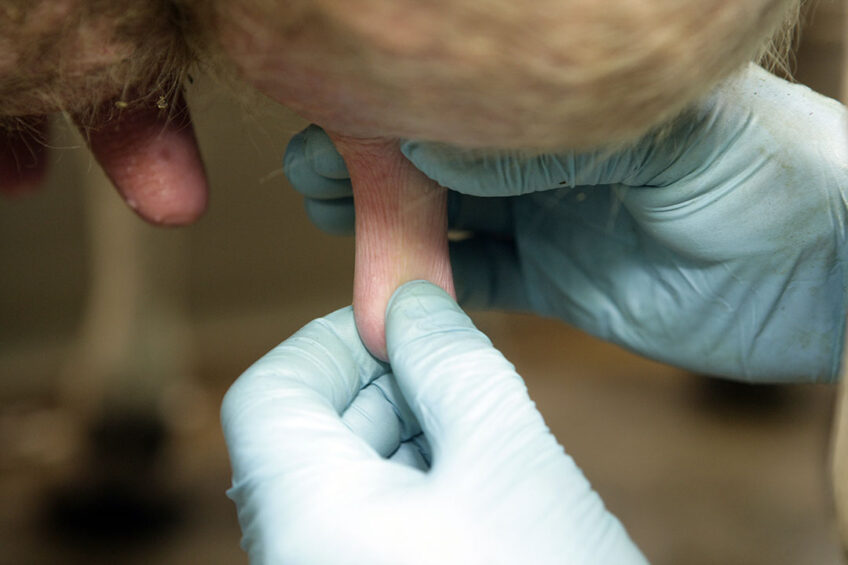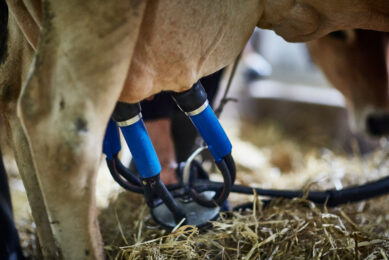6 tips for managing mastitis

Mastitis, a type of inflammation of the udder, can be one of the most profit-inhibiting problems in the dairy business.
When a cow has mastitis, somatic cell counts (SCCs) go up. General milk processors prefer SCC levels at or below 200,000, so anything more can be deemed as low-quality milk.
Plus, cows with high SCC numbers due to infection can produce far less milk. SCC numbers go up due to inflammatory response linked to exposure to either environmental or contagious bacteria. Therefore, managing mastitis and mastitis risk factors among your cowherd are vital.
Careful management practices can keep issues with mastitis at bay, keep production levels up, and help your dairy maintain a stable profit margin.

 Maintain a clean and dry environment for the entirety of your cowherd
Maintain a clean and dry environment for the entirety of your cowherd
Environmental mastitis can be problematic even if you don’t have issues with contagious mastitis, which is caused primarily by strep or staph bacteria. Infectious organisms in the environment can be resistant to antibiotic treatment, so managing the cowherd’s environment is crucial to thwarting ongoing problems with mastitis. In general, your cows should have a clean and dry environment in both the barn and the milking parlour. Keep the milk deck clean, change parlour liners at least every few thousand milkings, and make sure cows have clean, dry bedding. Implement cubicles if necessary to encourage proper lying in, and ensure housing and milking areas have the proper drainage and get scraped of manure frequently.
 Fighting mastitis with feed strategies
Fighting mastitis with feed strategies
Mastitis continues to be a problem for dairy producers, afflicting 15–20% of cows worldwide. We look at controlling mastitis through feed strategies. Read more…
 Practice careful udder hygiene practices at milking time
Practice careful udder hygiene practices at milking time
Simple-to-implement hygiene practices during milking could be deemed as the single most important component of managing mastitis effectively. Something as simple as post-milking teat disinfection can reduce infection rates by 50%. Likewise, pre-milking teat disinfection has been clinically shown to deter both contagious and environmental pathogens and lead to lower rates of infection caused by either source.
A few best-practices to follow include:
- Use top-quality disinfecting products
- Ensure full teat coverage during disinfectant dips
- Encourage all employees to wear gloves while treating and milking
- Keep hands disinfected after dealing with a cow suspected of having mastitis
- Maintain and disinfect milking clusters
In addition, if cows have a high SCC, make sure you are using a good oily antibiotic that has more staying power post-milking. You may also want to consider internal teat sealers, which can lower the risks of infective agents entering the cow’s teats.
 Follow antibiotic therapy protocols as soon as mastitis is detected
Follow antibiotic therapy protocols as soon as mastitis is detected
Deviating from the general recommended mastitis antibiotic therapy protocol can affect rates of infection.
The typical recommended antibiotic therapy protocol involves:
- Initiating treatment quickly
- Administrating all recommended antibiotic treatments over a course of time
- Keeping careful records of antibiotic treatment and which cow is being treated
- Testing milk for antibiotics after therapy concludes to ensure the cow can be safely added back to the milking herd
 New advancements in udder health management
New advancements in udder health management
Differential somatic cell count (DSCC) is a new supplementary parameter to SCC for udder health management. Using these 2 parameters in combination leads to better identification of mastitis at the end of the lactation period and thus can be valuable regarding dry cow therapy decisions. Read more…
 Cull or eradicate cows with chronic mastitis problems
Cull or eradicate cows with chronic mastitis problems
An important but often disregarded component of mastitis management is proper culling. If you have cows in your herd that are chronically infected, you run the risk of that single cow infecting the rest of your cowherd. If you have cows that don’t respond to antibiotic therapy, consistently have high SCCs, and test positive for contagious types of mastitis, culling or eradicating the cow can help protect the rest of the herd.
 Be mindful of cowherd nutrition and affiliation with mastitis
Be mindful of cowherd nutrition and affiliation with mastitis
Nutrition plays a vital role in deterring problems with mastitis because a healthy cow has a better immune system.
A few key aspects of nutrition to keep an eye on include:
- Preventing overfeeding during dry periods of late lactation
- Keep trace minerals and vitamin intake in check
- Manage sodium and potassium intakes among pregnant cows
- Lower supplemental fat delivery after calving
- Monitor caloric intake and keep it high during the initial days of post-fresh
 Keep good records of mastitis trends among your herd
Keep good records of mastitis trends among your herd
Documenting instances of mastitis and SCC counts should be a priority. With points of reference, you can identify trends in mastitis incidents in relation to SCC numbers, seasons, and more. Monitoring SCC numbers also allows you to catch on quickly when changes need to be made. For example, if you recognise SCC numbers are higher than usual for fresh cows, you know adjustments are necessary for dry or fresh cows heading into lactation.
Ideally, mastitis should be countered before becoming a problem. With good mastitis management practices in place, you can reduce the number of infections and also detect cases earlier, react more quickly, and reduce the impact across your cowherd and on the quality of your milk.
Join 13,000+ subscribers
Subscribe to our newsletter to stay updated about all the need-to-know content in the dairy sector, two times a week.










